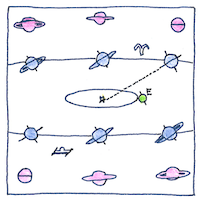Christiaan Huygens, James Clerk Maxwell
astronomy

|
Rings of Saturn
Galileo Galilei observed two children of Saturn in 1619. “I have observed the most distant planet to have a triple form.” In 1656, Christiaan Huygens explained that Saturn was surrounded by thin flat disk. “a thin, flat ring, nowhere touching, and inclined to the ecliptic.” Astronomers thought the disk consisted of solid or liquid rings. Giovanni Cassini discovered a gap in 1675. James Clerk Maxwell did the math in 1855 to prove the rings were made of individually orbiting particles that he called “brick-bats.”
Rings
Colliding moons, cataclismic comets, asteroidal concussions, intricate and dramatic interweavings might have spread out Saturn her rings, and no one was watching.
Orbital resonances
Orbital resonances partly explain gaps in the rings of Saturn. Moons and moonlets shepherd the rings like border collies herding sheep, like women winding hair about their fingers.



Maxwell has had the final word on the composition of the rings; however, much fine detail has been discovered and many new questions raised from information beamed back to Earth by NASA’s Pioneer, Voyager, and Cassini spacecrafts.
Mimas, Enceladus, Tethys, Dione, Rhea, Titan, and Iapetus are Saturn’s major moons. In addition to these and the particles and aggregates of the rings, there are fifty-five smaller moons and over a hundred and fifty moonlets.
See also in The book of science:
Readings in wikipedia: